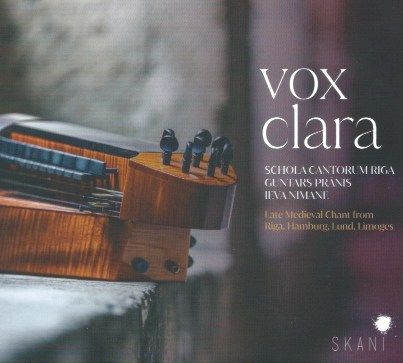Vox Clara: Late Medieval Chant

Although in one sense a Christmas disc (many of the texts sing about related subjects), it would be churlish to exclude this lovely disc on the basis we're now in January. Imagining the sounds of medieval Riga, and dispelling any sense of stuffy, voice-bound-to-text performance practice, this is a collection of chants backed by instruments such as the bagpipes, hurdy gurdy and the kokle, a Baltic zither. It is a remarkable adventure.
The performers are the Schola Cantorum Riga the resident vocal group of Riga Cathedral (the largest cathedral of the Baltics); and the disc encompasses repertoire from their home city (in what would then have been known as Livonia rather than Latvia) as well as Hamburg, Lund and Limoges: unexpectedly cosmopolitan, one might suggest. Although we're in a different era, one might suggest this disc as a perfect companion to a previous disc recommended by Classical Explorer: The Suspended Harp of Babel on ECM, a celebration of the Estonian tradition in the music of Kreek.
Here's the Schola Cantorum Riga's own introduction to the disc:
The result of this mixing of instruments and late Medieval chant is spellbinding. Try this, the versus Uterus Hodie:
... or the haunting instrumental opening to the Hymnus Plangas cum lacrimis:
The music includes example of elements of the ancient form of traditional Latvian vocal polyphony, Teikšana or saukšana (“saying” or “calling”), as can be heard in Miserere Mei, a Gergorian "cantus falsobordone". Veni Sancte Spiritus is sung in the early Livonian language, and the ensemble decided to sing the Latin words throughout the album in their local Latvian accent.
These are important documents as well as being toe-curlingly beautiful. The "Kyrie eleison ymas" is from Riga Cathedral's 15th-century Riga Missal (Missale Rigense) manuscript:
Led by Guntars Prānis, himself an expert in his field, this disc celebrates in the liveliest, but also most profound, fashion how liturgical music sat alongside improvisation. The performances just sound alive. By taking music from various locations, we travel across medieval Europe while looking through a decidedly Latvian pair of eyes; it is a journey like no other (it even includes a chant about a unicorn), and is fully worthy of exploration.
